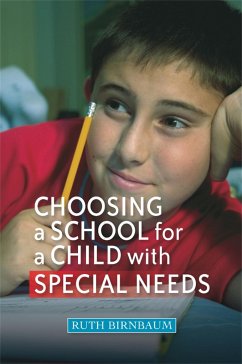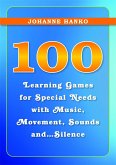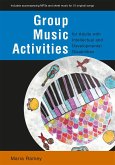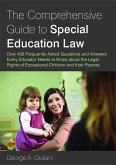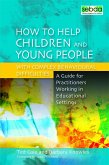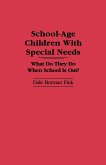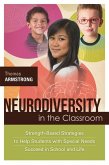Ruth Birnbaum
Choosing a School for a Child with Special Needs
Ruth Birnbaum
Choosing a School for a Child with Special Needs
- Broschiertes Buch
- Merkliste
- Auf die Merkliste
- Bewerten Bewerten
- Teilen
- Produkt teilen
- Produkterinnerung
- Produkterinnerung
From drawing up a list of possibilities and setting up a school visit, to asking the right questions and recording your opinions in order to make an informed decision, Choosing a School for a Child with Special Needs will guide you through this complex and stressful process with confidence and ease.
Andere Kunden interessierten sich auch für
![100 Learning Games for Special Needs with Music, Movement, Sounds And...Silence 100 Learning Games for Special Needs with Music, Movement, Sounds And...Silence]() Johanne Hanko100 Learning Games for Special Needs with Music, Movement, Sounds And...Silence35,99 €
Johanne Hanko100 Learning Games for Special Needs with Music, Movement, Sounds And...Silence35,99 €![Group Music Activities for Adults with Intellectual and Developmental Disabilities Group Music Activities for Adults with Intellectual and Developmental Disabilities]() Maria RameyGroup Music Activities for Adults with Intellectual and Developmental Disabilities57,99 €
Maria RameyGroup Music Activities for Adults with Intellectual and Developmental Disabilities57,99 €![The Comprehensive Guide to Special Education Law The Comprehensive Guide to Special Education Law]() George A GiulianiThe Comprehensive Guide to Special Education Law56,99 €
George A GiulianiThe Comprehensive Guide to Special Education Law56,99 €![How to Help Children and Young People with Complex Behavioural Difficulties How to Help Children and Young People with Complex Behavioural Difficulties]() Barbara KnowlesHow to Help Children and Young People with Complex Behavioural Difficulties40,99 €
Barbara KnowlesHow to Help Children and Young People with Complex Behavioural Difficulties40,99 €![School-Age Children with Special Needs School-Age Children with Special Needs]() Dale B. FinkSchool-Age Children with Special Needs63,99 €
Dale B. FinkSchool-Age Children with Special Needs63,99 €![Choosing Home Choosing Home]() Martha K. HartnettChoosing Home27,99 €
Martha K. HartnettChoosing Home27,99 €![Neurodiversity in the Classroom Neurodiversity in the Classroom]() Thomas ArmstrongNeurodiversity in the Classroom36,99 €
Thomas ArmstrongNeurodiversity in the Classroom36,99 €-
-
-
From drawing up a list of possibilities and setting up a school visit, to asking the right questions and recording your opinions in order to make an informed decision, Choosing a School for a Child with Special Needs will guide you through this complex and stressful process with confidence and ease.
Hinweis: Dieser Artikel kann nur an eine deutsche Lieferadresse ausgeliefert werden.
Hinweis: Dieser Artikel kann nur an eine deutsche Lieferadresse ausgeliefert werden.
Produktdetails
- Produktdetails
- Verlag: Jessica Kingsley Publishers
- Seitenzahl: 288
- Erscheinungstermin: 15. November 2009
- Englisch
- Abmessung: 226mm x 150mm x 23mm
- Gewicht: 431g
- ISBN-13: 9781843109877
- ISBN-10: 1843109875
- Artikelnr.: 26561880
- Herstellerkennzeichnung
- Libri GmbH
- Europaallee 1
- 36244 Bad Hersfeld
- 06621 890
- Verlag: Jessica Kingsley Publishers
- Seitenzahl: 288
- Erscheinungstermin: 15. November 2009
- Englisch
- Abmessung: 226mm x 150mm x 23mm
- Gewicht: 431g
- ISBN-13: 9781843109877
- ISBN-10: 1843109875
- Artikelnr.: 26561880
- Herstellerkennzeichnung
- Libri GmbH
- Europaallee 1
- 36244 Bad Hersfeld
- 06621 890
Ruth Birnbaum is a Chartered Educational Psychologist in independent practice, with 27 years' experience in the field of education. A trained teacher with a Masters degree in Educational Psychology, she now visits schools across the UK to consider provision and advise parents and legal consultants on which schools are most appropriate for which children.
Acknowledgements. Explanatory Terms. Introduction. Part 1 - Looking at
Specific Definitions of Special Educational Needs. 1. The Definition of
Special Educational Needs. 2. Communication and Interaction. 3. Cognition
and Learning. 4. Behaviour, Emotional and Social Development. 5. Sensory
and Physical Needs. 6. Complex Needs. 7. Medical Needs and School Trips. 8.
The Current Law on Special Educational Needs. Part 2 - Understanding the
Background. 9. Understanding the Child's Needs and the Role of Assessment
by a Psychologist. 10. How to Draw Up a List of Schools. 11. Getting the
Right Documents. Part 3 - Setting Up a Visit. 12. How to Set Up a Visit.
13. Looking at the Physical School Environment in General. 14. Looking at
the Classroom Environment. 15. Making a Record of the School Visit. Part 4
- Looking at Specific Provision/Intervention. 16. Teaching for Specific
Learning Difficulties. 17. Intervention for Sensory Needs. 18. Autistic
Provision. 19. Music Therapy, Drama Therapy, Play Therapy and
Psychotherapy. 20. Counselling and Mentoring. 21. Speech and Language
Therapy. 22. Occupational Therapy. 23. Physiotherapy. Part 5 - Other
Important Issues to Consider. 24. Integration and Inclusion. 25. Religious
Beliefs, Co-Education, Small Classes, School Size and Transition. 26.
Equality and Discrimination. Part 6 - Different School Models. 27.
Mainstream Schools. 28. Special Units in Mainstream Schools. 29. Special
Schools. 30. Dual Placements. 31. Pupil Referral Units. 32. Residential
Schools. 33. Home Education. 34. Hospital Schools. 35. Studio Schools and
Virtual Schools. Part 7 - Summary. 36. Evaluating the Findings.
Bibliography. Resources and Useful Organisations. Websites. Index
Specific Definitions of Special Educational Needs. 1. The Definition of
Special Educational Needs. 2. Communication and Interaction. 3. Cognition
and Learning. 4. Behaviour, Emotional and Social Development. 5. Sensory
and Physical Needs. 6. Complex Needs. 7. Medical Needs and School Trips. 8.
The Current Law on Special Educational Needs. Part 2 - Understanding the
Background. 9. Understanding the Child's Needs and the Role of Assessment
by a Psychologist. 10. How to Draw Up a List of Schools. 11. Getting the
Right Documents. Part 3 - Setting Up a Visit. 12. How to Set Up a Visit.
13. Looking at the Physical School Environment in General. 14. Looking at
the Classroom Environment. 15. Making a Record of the School Visit. Part 4
- Looking at Specific Provision/Intervention. 16. Teaching for Specific
Learning Difficulties. 17. Intervention for Sensory Needs. 18. Autistic
Provision. 19. Music Therapy, Drama Therapy, Play Therapy and
Psychotherapy. 20. Counselling and Mentoring. 21. Speech and Language
Therapy. 22. Occupational Therapy. 23. Physiotherapy. Part 5 - Other
Important Issues to Consider. 24. Integration and Inclusion. 25. Religious
Beliefs, Co-Education, Small Classes, School Size and Transition. 26.
Equality and Discrimination. Part 6 - Different School Models. 27.
Mainstream Schools. 28. Special Units in Mainstream Schools. 29. Special
Schools. 30. Dual Placements. 31. Pupil Referral Units. 32. Residential
Schools. 33. Home Education. 34. Hospital Schools. 35. Studio Schools and
Virtual Schools. Part 7 - Summary. 36. Evaluating the Findings.
Bibliography. Resources and Useful Organisations. Websites. Index
Acknowledgements. Explanatory Terms. Introduction. Part 1 - Looking at
Specific Definitions of Special Educational Needs. 1. The Definition of
Special Educational Needs. 2. Communication and Interaction. 3. Cognition
and Learning. 4. Behaviour, Emotional and Social Development. 5. Sensory
and Physical Needs. 6. Complex Needs. 7. Medical Needs and School Trips. 8.
The Current Law on Special Educational Needs. Part 2 - Understanding the
Background. 9. Understanding the Child's Needs and the Role of Assessment
by a Psychologist. 10. How to Draw Up a List of Schools. 11. Getting the
Right Documents. Part 3 - Setting Up a Visit. 12. How to Set Up a Visit.
13. Looking at the Physical School Environment in General. 14. Looking at
the Classroom Environment. 15. Making a Record of the School Visit. Part 4
- Looking at Specific Provision/Intervention. 16. Teaching for Specific
Learning Difficulties. 17. Intervention for Sensory Needs. 18. Autistic
Provision. 19. Music Therapy, Drama Therapy, Play Therapy and
Psychotherapy. 20. Counselling and Mentoring. 21. Speech and Language
Therapy. 22. Occupational Therapy. 23. Physiotherapy. Part 5 - Other
Important Issues to Consider. 24. Integration and Inclusion. 25. Religious
Beliefs, Co-Education, Small Classes, School Size and Transition. 26.
Equality and Discrimination. Part 6 - Different School Models. 27.
Mainstream Schools. 28. Special Units in Mainstream Schools. 29. Special
Schools. 30. Dual Placements. 31. Pupil Referral Units. 32. Residential
Schools. 33. Home Education. 34. Hospital Schools. 35. Studio Schools and
Virtual Schools. Part 7 - Summary. 36. Evaluating the Findings.
Bibliography. Resources and Useful Organisations. Websites. Index
Specific Definitions of Special Educational Needs. 1. The Definition of
Special Educational Needs. 2. Communication and Interaction. 3. Cognition
and Learning. 4. Behaviour, Emotional and Social Development. 5. Sensory
and Physical Needs. 6. Complex Needs. 7. Medical Needs and School Trips. 8.
The Current Law on Special Educational Needs. Part 2 - Understanding the
Background. 9. Understanding the Child's Needs and the Role of Assessment
by a Psychologist. 10. How to Draw Up a List of Schools. 11. Getting the
Right Documents. Part 3 - Setting Up a Visit. 12. How to Set Up a Visit.
13. Looking at the Physical School Environment in General. 14. Looking at
the Classroom Environment. 15. Making a Record of the School Visit. Part 4
- Looking at Specific Provision/Intervention. 16. Teaching for Specific
Learning Difficulties. 17. Intervention for Sensory Needs. 18. Autistic
Provision. 19. Music Therapy, Drama Therapy, Play Therapy and
Psychotherapy. 20. Counselling and Mentoring. 21. Speech and Language
Therapy. 22. Occupational Therapy. 23. Physiotherapy. Part 5 - Other
Important Issues to Consider. 24. Integration and Inclusion. 25. Religious
Beliefs, Co-Education, Small Classes, School Size and Transition. 26.
Equality and Discrimination. Part 6 - Different School Models. 27.
Mainstream Schools. 28. Special Units in Mainstream Schools. 29. Special
Schools. 30. Dual Placements. 31. Pupil Referral Units. 32. Residential
Schools. 33. Home Education. 34. Hospital Schools. 35. Studio Schools and
Virtual Schools. Part 7 - Summary. 36. Evaluating the Findings.
Bibliography. Resources and Useful Organisations. Websites. Index

